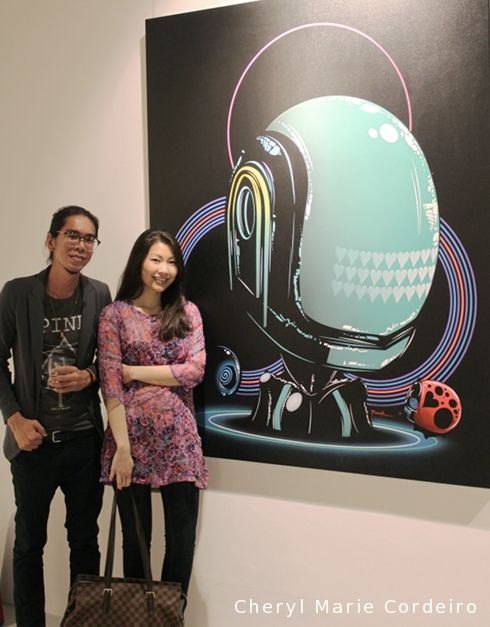Cheryl Cordeiro and Alvin Tan with his art, at Phunk Studio’s Empire of Dreams exhibition, January 2013, Singapore. Phunk Studio is a gallery space that illustrates an integral perspective expressed through art.
Text and Photo © JE Nilsson, CM Cordeiro 2013
I’ve been reading Doriane L. Coleman (1996), Jürgen Habermas (1976) and Ken Wilber (2000), where I’m finding a lot of humour in Wilber’s writings in how he incorporates Habermas into his own philosophical reasoning, specifically talking of how some disciplines argue themselves lost into aperspectival space usually at higher levels of development within the individual, the organizational, national and transnational realms. More thoughtful and filled with much less humour is the article by Coleman on “cultural defense” and “the Liberals’ Dilemma”.
This article is an exploration in thought on the dialectic of progress, the nature of multiculturalism (and its consequences when used in court as a “cultural defense”) and aperspectival fallacy.

Phunk, Daydreamers 5 by Alvin Tan (Phunk Newspaper). I find the fabric of Singapore in itself morphing each time I go back for a visit, much of what is being reflected in art is an impressive collage, if not an amalgamation of pluralistic perspectives, derived from various cultures not just those existing in Singapore, but from the region.
Habermas’ dialectic of progress
One defining aspect of evolution is how it brings new and emergent possibilities and with that, a period of stability and then an onset of new and potential challenges (or as Wilber labels, ‘pathologies’) that once again need solving. In Habermas’ work, Communication and the Evolution of Society (1976), he concludes that evolutionarily important innovations means not only a new level of learning but a new problem situation as well, so that a new category of burdens that accompany the new social formation will come to awareness.
A higher stage of development of productive forces and of social integration brings relief from problems of the superseded social formation. Still the problems associated with the new stage of development will eventually increase in intensity. Every stage of development in the social-evolutionary learning process itself generates new resources, which leads to new dimensions of scarcity and needs.
From Habermas (1976:164):
With the transition to the sociocultural form of life, that is, with the introduction of the family structure, there arose the problem of demarcating society from external nature. In neolithic societies, at the latest, harmonizing society with the natural environment became thematic. Power over nature came into consciousness as a scarce resource. The experience of powerlessness in relation to the contingencies of external nature had to be interpreted away in myth and magic. With the introduction of a collective political order, there arose the problem of the self-regulation of the social system. In developed civilizations, at the latest, the achievement of order by the state became a central need. Legal security came to consciousness as a scarce resource. The experience of social repression and arbitrariness had to be balanced with legitimation of domination. This was accomplished in the framework of rationalized world views. In the modern age, with the autonomization of the economy, there arose the problem of a self regulated exchange of the social system with external nature. In industrial capitalism, at the latest, society consciously placed itself under the imperatives of economic growth and increasing wealth. Value came into consciousness as a scarce resource. The experience of social inequality called into being social movements and corresponding strategies of appeasement. These seemed to lead to their goal in social welfare state mass democracies. Finally, if postmodern societies, as they are today envisioned from different angles, should be characterized by a primacy of the scientific and educational systems, one can speculate about the emergence of the problem of a self-regulated exchange of society with internal nature. Again a scarce resource would become thematic – not the supply of power, security or value, but the supply of motivation and meaning.
What Habermas describes above is the natural progression of development in the human society, where at the level of the individual, it is akin to the cycle of life, from foetus to birth, adolescence, adulthood, old age and death, not the other way around. Each level reached is a new, higher order of developmental stage that brings with it a different set of pathologies, after first diffusing some central problems and limitations of the previous stage.
It is here that Habermas and Wilber both put forth similar critiques of romantic regressions towards the development of new pathologies to the new context of situation that left unchecked, turns into aperspectival fallacy.
To only take the pathologies of the higher order and compare them with only the achievements of the previous stage or lower level orders is aberrant and unhelpful. What is required rather, is a balanced view that takes into account the limitations and failures of the previous level of order that necessitated and catalysed the new evolutionary transformation to a higher order.
Concession of some sovereignty for the greater good
Transformation is global in nature, particularly in modernity where the broad tripartite factors of knowledge, technology and economy forms its foundation. What thus makes the most pressing issues of global concern, issues that are not affected by individual nation efforts or national boundaries today are three that include (i) the common biosphere, (ii) the world financial system and (iii) cross border defense, security and peace keeping. These issues need a world centric perspective, one that transcends nation states to encompass a post national perspective.
The managing and solving of such world centric issues on the sociology-ecological and financial front will need a corresponding shift in consciousness from leaders of nations and likewise, when filtered downwards, to each individual of each nation. Nothing less than a paradigm shift in defining oneself in relation to, not just the domain of the immediate family, or of society or even of country, but in relation to the global community.
This in itself will be a losing proposition if in the current global structures, individuals as well as state governments are not allowed to or are somehow unable to perceive the greater advantage in the smaller sacrifice, the concession of some sovereignty for the greater good.

North Bridge Road, Singapore. Singapore’s multicultural heritage is often times reflected in its streets and buildings, from street names to building architecture, both old and new. That Singapore is a place that needs for both its people and government to understand true multiculturalism and be multicults at the core is due to its small and ever vulnerability to global processes.
Multiculturalism and aperspective fallacy
The single greatest world transformation would simply be the embrace of global reasonableness and pluralistic tolerance. Cultural tolerance is secured when understood as a universal pluralism, and by having the capacity to mentally put yourself into the other person’s shoes and then decide to honour or at least tolerate that perspective even if you don’t agree with it.
But to tolerate a perspective that is not your own should not be conflated with and equated with, “all perspectives are equally good”. As Wilber (2000) puts forth:
“Put differently, multiculturalism is a noble attempt to move to the integral-aperspectival structure, but, like many postmodern poststructuralists, it throughly confuses the fact that no perspective is final with the notion that all perspectives are therefore simply equal. It thus fails to notice that the stance itself actually (and appropriately) rejects all narrower perspectives (which clearly shows that not all perspectives are not equal).
In other words, the “multicults” regress from “no stance is ultimate” to “every stance is equally acceptable”, thus buying (and denying) their own otherwise accurate judgment that lesser stances and smaller perspectives are unacceptable.” (Wilber 2000:207)
Wilber continues to outline the problem of true multiculturalism, which is that it seems to misidentify its own stance and claims to be not rational because some of the things it tolerates are not rational. But its own tolerance is rational through and through, and rightly so. Rationality is the only structure that will tolerate structures other than itself.
Genuine multiculturalism cannot be established on purely emotional grounds because feelings are individual, what I feel is not what you feel, is not what they feel. Only in the space of rational pluralism can different thoughts, including feelings and desires be given fair play and an equal voice.
It is from this platform of rational pluralism that the next stage, that of an integral aperspective can be reached. But like many post modern post structuralists, it thoroughly conflates aberrantly, the fact that no perspective is final with the notion that all perspectives are therefore simply equal, failing to notice that the stance itself actually and appropriately rejects all narrower perspectives, thus supporting that at its core, that all perspectives are not equal.
Thus, that everything is relative does not either mean nothing is better. Based on the logic of developmental stages and on the physical laws of nature, where each level of development inevitably encompasses and supersedes the level below, it means some things are indeed, relatively better than others, all the time.
Even Einstein’s mislabeled “relativity theory” is not that all things are relative but rather, it is to find invariant transforms across relative space time. This is in order to show that though the system in itself is relative and sliding, it slides in stable ways so as to render stability-in-relativity and with that, the capacity to render accurate judgements for the greater good. So for example, pluralistic tolerance does much more social good than a narrow minded intolerance. And even when the multicult theory (often mistaken to be that “they have no judgement since all judgements are relative”) in fact seemingly denies their actual stance, what a true understanding of multiculturalism does, is to render correct judgements for a given context of situation.
Examples of the consequences of failing to see the definiteness of relative judgements are the following court cases cited in Coleman’s article, “Individualizing justice through multiculturalism: the Liberals’ dilemma” in the Columbia Law Review (June 1996, 96(5):1093-1167):
In California, a Japanese-American mother drowns her two young children in the ocean at Santa Monica and then attempts to kill herself; rescuers save her before she drowns. The children’s recovered bodies bear deep bruises where they struggled as their mother held them under the water. The mother later explains that in Japan, where she is from, her actions would be understood as the time-honoured, customary practice of parent-child suicide. She spends one year in jail – the year she is on trial.
In New York, a Chinese-American woman is bludgeoned to death by her husband. Charged with murder, her husband explains that his conduct comports with a Chinese wisdom that allows husbands to dispel their shame in this way when their wives have been unfaithful. He is acquitted of murder charges.
In California, a young Laotian-American woman is abducted from her work place at Fresno State University and forced to have sexual intercourse against her will. Her Hmong immigrant assailant explains that, among his tribe, such behaviour not only is accepted, but expected – it is the customary way to choose a bride. He is sentenced to 120 days in jail and his victim receives USD$900 in reparations.
A Somali immigrant living in Georgia allegedly cuts off her two-year old niece’s clitoris, partially botching the job. The child was cut in accordance with the time-honored tradition of female circumcision; this custom attempts to ensure that girls and women remain chaste for their husbands. The State charges the woman with child abuse, but is unable to convict her.
This strategy is labelled “cultural defense” and can be used to excuse otherwise criminal conduct of immigrant defendants. While Coleman goes on to put these cases in the American multiculturalist context, arguing its pros and cons in what she calls the “Liberals’ Dilemma”, it is today, experienced by many more countries who have now seen a greater flow of immigrant movements in the past decade.
The non-understanding of the definiteness of relative judgements, and the resulting disorientation of being lost in aperspectival space is often where multicults regress, that unfortunately destroys the original integrity of their own position; what is missed completely is the integral aperspectivism of pluralistic tolerance and multiculturalism.
Coleman makes a strong argument in conclusion that “multiculturalism should not be permitted either intentionally or incidentally erode the progress we have made as culture in protecting the rights of minorities, women and children, or to reverse our relative success in elevating the rights of these groups to the level traditionally enjoyed by propertied men of European descent… the cultural defense is irreconcilable with this [broader] core [of American culture] because it permits customary practices such as female genital mutilation, mother-child suicide, marriage-by-capture, and other gender-motivated violence to escape the full sanction of the criminal law. For that reason, it must yield.” (p 1167)
And it is in this yielding that multiculturalism returns to, and illustrates, its own universal integral stance.
References
- Coleman, D.L. 1996. Individualizing justice through multiculturalism: the Liberals’ dilemma, Columbia Law Review, 96(5):1093-1167.
- Habermas, J. 1976. Zur Rekonstruktion des Historischen Materialismus. Frankfurt am Main: Suhrkamp. [English, 1979]
- Wilber, K. 2000. Sex, ecology, spirituality: the spirit of evolution. Shambhala: Boston and London.
Bibliography
- Arpi, Ivar, 2013. Ledarskribent. Rastänkandets plats är på historiens sophög. SvD, Ledarsidan, 31 March 2013.
